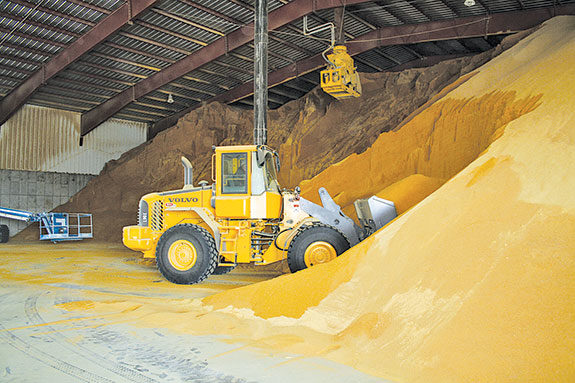Distillers grains are high in fibre and protein, and are frequently used in diets for cattle as protein supplements.
Canola meal is a byproduct of the edible oil industry. Canola meal is another somewhat fibrous protein source available for feeding to dairy cattle.

The three ingredients are compared in Table 1. Wheat distillers grains have about the same amount of protein as canola meal and more than corn distillers grains.
Canola meal contains less fibre than the two distillers grains products.
Distillers grains are often less costly per tonne than canola meal.
In spite of that fact, many nutritionists find that they must limit the level of inclusion in the diet, or else sacrifice milk production. Savings in the cost of the feed is offset by the loss in milk revenue.
A major issue with both sources of distillers grains is that they do not provide a very good balance of the amino acids – the building blocks of protein.
The cow needs to be able to absorb these nutrients in order to maintain body condition and to produce milk. When essential amino acids are limiting, milk production suffers. Canola meal has a much better balance of amino acids than distillers grains relative to the needs of the dairy cow.
Studies conducted at the University of Saskatchewan by Dr. Tim Mutsvangwa showed that greater quantities of protein and key amino acids were available for milk protein synthesis when cows were given diets based on canola protein relative to wheat distillers grains. Results are illustrated in Figure 1.
The canola meal (red bars) provided higher levels of the amino acids lysine (lys), histidine (his), threonine (thr) and tryprophan (tryp) than did the wheat distillers grains (blue bars).
The two protein ingredients provided the same amount of the amino acid methionine (met).
From this study, Mutsvangwa hypothesized that a blend of the two proteins might provide the most economical outcome.
He and his team plan to evaluate mixtures in the near future in order to show the optimal balance of canola meal and wheat distillers grains in the diet.
Another study, conducted by Dr. Peter Robinson and his graduate student Nadia Swanepoel at the University of California, arrived at much the same conclusion for corn distillers grains.
Calculating that a blend of the two proteins would provide the best amino acid balance, they conducted a large study with more than 1,200 cows, comparing protein from distillers grains, protein from canola meal and two blends. All of the diets contained 17 percent protein.
As Table 2 shows, the cows in the study were producing almost 45 kilograms (100 pounds) of milk with the distillers grains.
This increased by more than 2 kilograms when canola meal was blended with the corn distillers grains.
Surprisingly, milk fat and protein yields were all higher with the blend than with the ingredients alone.
The milk-to-feed ratio was also greatly improved when canola meal was included in the diet.
These results show that it is possible to get more value from distillers grains by mixing this byproduct with canola meal.
The results suggest that distillers and canola meal is indeed a match made in heaven. PD

- Essi Evans
- Technical Advisory Services Inc.











